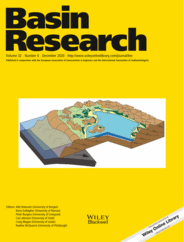
Full text loading...
 , Alexander C. Whittaker1, Peter A. Allison1, Daniel J. Lunt2, Alexander Farnsworth2
, Alexander C. Whittaker1, Peter A. Allison1, Daniel J. Lunt2, Alexander Farnsworth2
Left: Onshore palaeo‐digital elevation model (palaeoDEM) for the Cenomanian North American continent. Key palaeogeographic features are labelled, including the Sevier orogenic highlands, Laramidian landmass, Western Interior Seaway, Appalachian landmass, Hudson Seaway (HS) and Labrador Seaway (LS). Modern North American coastlines and country borders (solid black lines) have been palaeo‐rotated onto palaeoDEMs. Right: Spatial distributions of suspended sediment discharges (Qs) for the Cenomanian North American continent. Qs values overlay palaeoDEM hillshades for comparison with palaeotopography.
Depositional stratigraphy represents the only physical archive of palaeo‐sediment routing and this limits analysis of ancient source‐to‐sink systems in both space and time. Here, we use palaeo‐digital elevation models (palaeoDEMs; based on high‐resolution palaeogeographic reconstructions), HadCM3L general circulation model climate data and the BQART suspended sediment discharge model to demonstrate a predictive, forward approach to palaeo‐sediment routing system analysis. To exemplify our approach, we use palaeoDEMs and HadCM3L data to predict the configurations, geometries and climates of large continental catchments in the Cenomanian and Turonian North American continent. Then, we use BQART to estimate suspended sediment discharges and catchment‐averaged erosion rates and we map their spatial distributions. We validate our estimates with published geologic constraints from the Cenomanian Dunvegan Formation, Alberta, Canada, and the Turonian Ferron Sandstone, Utah, USA, and find that estimates are consistent or within a factor of two to three. We then evaluate the univariate and multivariate sensitivity of our estimates to a range of uncertainty margins on palaeogeographic and palaeoclimatic boundary conditions; large uncertainty margins (≤50%/±5°C) still recover estimates of suspended sediment discharge within an order of magnitude of published constraints. PalaeoDEMs are therefore suitable as a first‐order investigative tool in palaeo‐sediment routing system analysis and are particularly useful where stratigraphic records are incomplete. We highlight the potential of this approach to predict the global spatio‐temporal response of suspended sediment discharges and catchment‐averaged erosion rates to long‐period tectonic and climatic forcing in the geologic past.
]
Article metrics loading...

Full text loading...
References


Data & Media loading...

